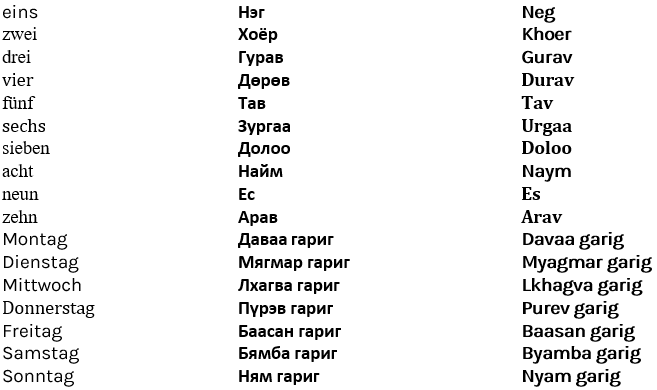Interesting facts about the language
Mongolian is spoken by almost six million people today. The language can be divided into two main dialects: the approximately 2.3 million speakers in Mongolia speak Khalkha Mongolian. In the autonomous region of Inner Mongolia, which is part of the People's Republic of China, around 3.3 million people speak what is known as Southeastern Mongolian. However, their share of the population in Inner Mongolia only accounts for around 12 percent. Smaller Mongolian-speaking minorities can also be found in Russia, Taiwan, and Kyrgyzstan. Native speakers of Khalkha Mongolian and Southeastern Mongolian can generally converse easily.
The oldest written records of the Mongolian language date back to the 13th century AD. The traditional writing system of the Mongolian language is a modified version of the Uyghur script. Due to the immense power of the Mongol Empire at the time, the Mongolian script was the most widely used script in Asia during the Middle Ages. In the 1920s, Outer Mongolia came under increasing Soviet influence, which led to far-reaching reforms of the language. In 1931, the Latin script was introduced for Khalkha Mongolian, which in turn was replaced by the (slightly modified) Cyrillic alphabet from 1937 onwards. In 1941, the traditional script was officially abolished. In Inner Mongolia (People's Republic of China), however, the traditional script has always been used and is still used today. Since the late 1980s, however, the traditional Mongolian script has experienced a (small) renaissance in Outer Mongolia, and today you can once again find this traditional script on many businesses and company logos. However, the Cyrillic alphabet continues to be used in everyday writing, in newspapers, etc.
The Mongolian language belongs to the Altaic language family, whose individual languages are spoken in many countries of Southeastern Europe, the Middle East and Central Asia, as well as in Southern Siberia and Northern China. The most important representatives of the Altaic languages include the Turkic languages (e.g., Bulgarian, Uzbek, Azerbaijani, Kazakh, and Turkish) and the Mongolian language.
Demo version
Learn Mongolian for free for two days. Try the course and see for yourself how much faster you can learn Mongolian than you ever thought possible. Discover how learning Mongolian is finally fun and easy—and how this course truly motivates you to learn every day. You'll be surprised at how much you'll learn in just two days!
Länderinfo
Mongolei
Mongolia is a landlocked country in eastern Central Asia. It borders Russia to the north and the People's Republic of China to the south. Mongolia has a population of approximately 3 million. The country is four and a half times the size of Germany, but is the most sparsely populated country in the world. The largest city is the capital, Ulaanbaatar, where more than 40 percent of the country's population lives.
Sightseeing features
in Mongolia
On the following websites you will find information about the most beautiful sights in the country.
Benefits of learning the language!
- You will find your way around when you are on holiday in Mongolia.
- You broaden your horizons and thereby expand your educational level.
- You improve your career opportunities.
- They contribute to integration.
- They ensure better communication in bilingual relationships.
- This way you get to know a lot of people and can communicate with each other.
What’s special about the language course
- The language course is suitable for beginners.
- Learn a vocabulary of over 450 most important words for communication on vacation.
- Short daily learning time of only 17 minutes a day.
- The daily tasks are given to you and what you have already learned is repeated until it is stored in your long-term memory.
- Learn with different learning methods.
- You don't want to learn alone! Join learning communities and make new connections.
Online Sprachkurs:
- Neueste Version: Die Sprachkurse wurden im Jahr 2020 vollständig überarbeitet.
- Für Windows, Linux, Mac OS, iPhones, Android-Smartphones, IPad und Android-Tablets.
- Über 540.000 Sprachkurse wurden bereits verkauft.
- Software Made in Germany





